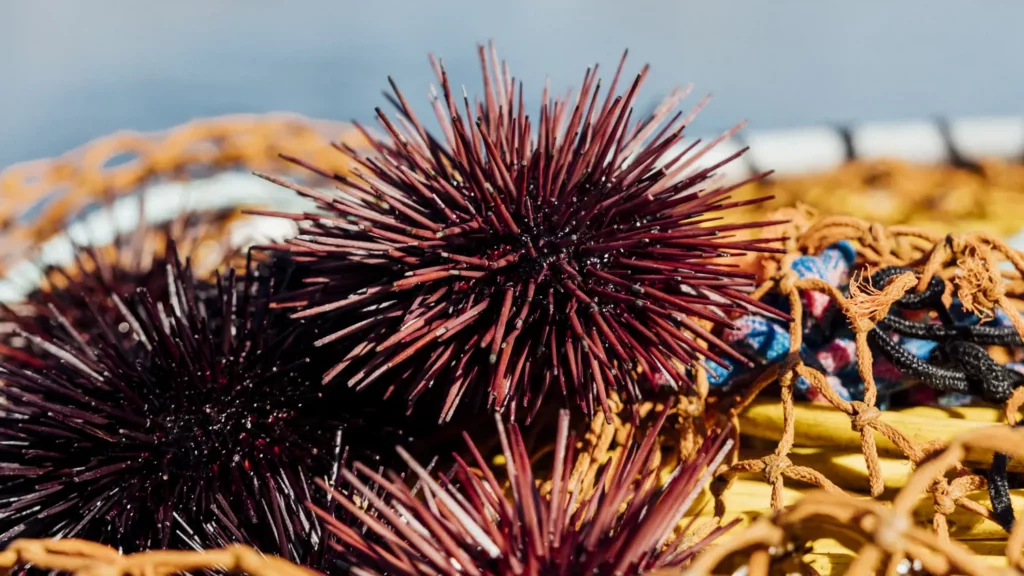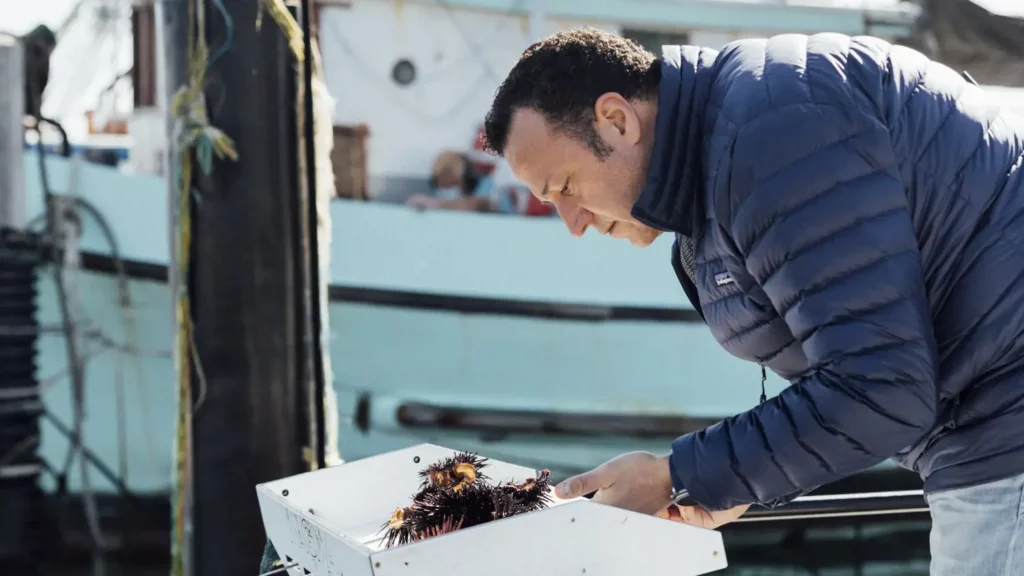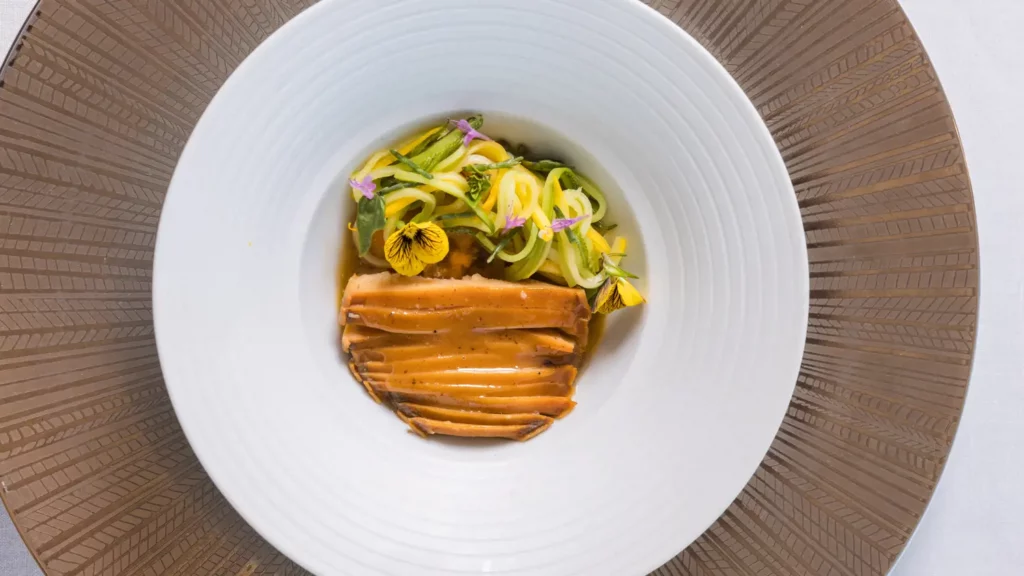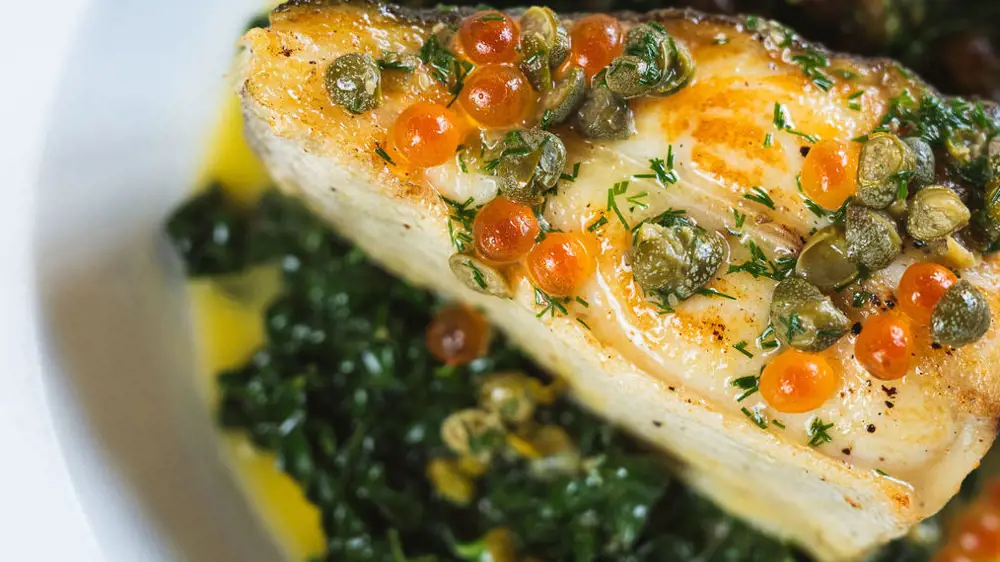Real Ways Restaurants are Sourcing Seafood Sustainably
22 October 2024
Share this exclusive content from Saladplate


Photo Credit: Caruso’s
IN THIS ARTICLE, WE EXPLORE HOW SOME OF THE RESTAURANTS IN OUR NETWORK ARE PUTTING THE THEORY OF SUSTAINABLE SEAFOOD SOURCING INTO PRACTICE.
1. Stop serving endangered or overfished species
Last week, we published a piece looking at the most critically endangered types of fish and seafood. It should go without saying that none of these should appear on menus, and removing them from yours is an important first step. You can use resources like the MCS Good Fish Guide to check how healthy stocks are, removing anything on the Red List from your offering. “That’s the very minimum your customers would expect,” says Jack Clarke, Sustainable Seafood Advocate at MCS. “The foodservice sector plays a hugely important role in this. At MCS, we encourage restaurants to source only seafood rated 1-3 on the Good Fish Guide.”
The procurement team at Peach Pubs is aware that the sustainability of scallops can vary a lot depending on the source. “We have removed all scallops from our menus over the last couple of years,” says Lindsay Hobbs, Senior Brand Manager. “If we have a scallop dish on the specials boards, we will only buy hand-dived scallops.”
Similarly, at The Palmerston in Scotland, salmon has never featured on the menu. “We’ve never served salmon, and we never will,” says Chef Lloyd Morse. “Wild salmon numbers are under threat for a variety of reasons, including wild populations being damaged due to sea lice and pollutants in the water from salmon farms.”
Illustrating that this strategy is just as possible for a small, casual offering as a high-end restaurant or large pub group, another UK example is Loki Poke, the Bristol-based food truck that won the Sustainability Award at the British Street Food Awards 2024. In a recent initiative, they swapped sashimi tuna – typically sourced from the Indian Ocean or the Western Pacific Ocean – for Hampshire Chalk Stream Trout, a local, sustainable alternative. Not only did they update their menus to reflect this change, but they also ran an awareness campaign to encourage customers to try the trout.
2. Diversify the species on your menu
A good rule is to deliberately focus on less common varieties of fish and seafood, as these are more likely to come from healthy stocks. This also provides a point of difference, helping your restaurant stand out from competitors. At CH&Co – one of the UK’s most successful catering companies – chefs are actively steering away from salmon, cod, haddock, prawns and tuna. (Known as the ‘Big Five’, these are the most commonly fished and consumed species of seafood in the UK, accounting for around 80% of all fish eaten there.) Their central chef teams now work with a broad range of fish, including hake, pollock, sea bass and megrim.
Ten years ago, Salvo Patria restaurant in Colombia started working within the framework of a programme funded by international cooperation to support responsible fishing projects in the Colombian Pacific. “This is backed by Conservation International, allowing us to ensure fair prices for fishing communities, purchase only seasonal species, respect fishing bans and minimum sizes for each species,” says Chef Alejandro Gutiérrez. “It has allowed us to travel to get to know fishing communities, learn more about uncommon species and structure our menu to offer different options. Since the programme started, we have worked with 33 species of fish, three bivalves and four crustaceans.” Alejandro says this diversity has provided more inspiration in the kitchen. “It allows us to be more creative with our dishes, making the most of each fish that arrives at the restaurant in a deeper way and generating as little waste as possible. We have also had the opportunity for our clients to learn about and enjoy other fish species offered by the immense biodiversity of the Colombian territory.”
As part of these diversification efforts, steer away from large predatory fish like salmon and tuna, focusing instead on options further down the food chain: think anchovies, mackerel, sardines and bivalves. Smaller fish and bivalves have a much lower environmental impact, as well as an often-overlooked nutritional value. For example, at Tate sites in the UK, they’ve replaced salmon with alternative marine ingredients from lower on the food chain, including bivalves.
A FISH BY ANY OTHER NAME
Don’t underestimate the power of a rebrand, either! Ever heard of Patagonian Toothfish? This fish was relatively unknown until 1977, when a seafood wholesaler from California “discovered” it off the coast of Chile. Realising that ‘toothfish’ would be viewed as an off-putting name by US consumers, he rebranded the fish, calling it the Chilean sea bass. The new moniker was so successful that demand in the US skyrocketed, leading to a plethora of illegal, unreported and unregulated (IUU) fishing; today, the species is actually overfished as a result!
On a smaller scale (and without the damaging outcomes), this approach has worked for Lussmanns in the UK. A close relative of Dover and lemon sole, megrim sole is a flat white fish with tender flesh and a slightly sweet flavour – and is plentiful in UK waters. Originally presented on the menu as megrim, sales weren’t great; however, after a rebrand as ‘whole Cornish sole’, it has become one of the three most popular options on the menu and one of Lussmanns’ flagship dishes.

Whole Cornish sole at Lussmanns.
Photo Credit: The Sustainable Restaurant Association (TSRA)
3. Use what’s available and in season
If you’re willing to work with what the sea has to offer, you can enjoy the benefits of fresh, local, in-season food while offering your customers a real sense of provenance.
At Caruso’s restaurant at the Rosewood Miramar Resort in California, the entire culinary offering is built around seasonality and responsible sourcing. “At Caruso’s, we are in symbiosis with the ocean; it is absolutely natural for us when we work on menu planning and ideas. No one in the team ever thinks of flying in fish from elsewhere or using something out of season – it’s just about mindset,” says Head Chef Massimo Falsini. “I have absolutely no problem using whichever species are available for our kitchen – our chefs must stay on their toes! As an example, we only use sea urchin from Stephanie Mutz, a local diver; when the weather is inclement and she is not going out, we simply change the menu. It is not hard, it is just what we do. It’s a chef’s responsibility to respect the environment, animal welfare and public health.”
Meanwhile, in Badauyao restaurant in Taiwan, the focus is on. locally-caught fish species from Keelung Harbour, and chefs are prepped to cook and serve whatever is available. Badauyao is a reservation-only restaurant, which allows them to serve only fish caught that morning or the previous evening. Letting their menus evolve with the changing bounty of the sea means that the seafood served in the restaurant varies daily, reflecting natural diversity.
4. Understand your supply chain
For all seafood you buy, ask all the questions you can of your supplier. Where, when and how was the fish sourced? You want to be confident that you know every part of the journey from the water to your kitchen, and that each supplier has the right practices in place. This due diligence process should be repeated with every new menu and with any new suppliers, as stock levels are always changing.
At Caruso’s, they work with SmartCatch, Oceanwise and Fishchoice to stay informed on what seafood is the best choice for their seasonal menus. “Working with these organisations, we prioritise accountability,” says Chef Massimo. “Every quarter, we submit our seafood purchase invoices – including the details of species and sourcing – to these organisations and they evaluate our impact on the ocean. This process keeps us in line and has been our modus operandi since we established Caruso’s five years ago. It is at the core of our seafood culinary R&D.”
At FYN restaurant in South Africa, the chefs work with Abalobi – a South African organisation that is striving to elevate small-scale fishing communities for social, economic and ecological sustainability – to source fish more sustainably and ensure that fishers are both treated well and paid well. The Caruso’s team is similarly committed to working with local fishers, which helps them to support local communities and reduce the carbon footprint of transportation.
Meanwhile, in Taiwan, Badauyao uses seafood certified with the Heart of the Ocean Ecological Label, jointly promoted by the Fisheries Agency of the Ministry of Agriculture and Taiwan Ocean Conservation and Fisheries Sustainability Foundation (TOFF). They also follow the recommendations of the Taiwan Seafood Selection Guide to serve only seafood listed under ‘Recommended for Consumption’. Badauyao only purchases fish species caught by small fishing boats; boat captains notify them when the fish is landed, and local fishmongers, who visit the Kan Zai Ding Fish Market the day before, reserve the freshest ones for the restaurant.
In the UK, CH&Co is also diligent about working closely with suppliers and collecting the right data for procurement. They’ve engaged with all their suppliers to specify that they will only purchase fish rated 1-3 [‘okay’ or ‘good to eat’] by MCS. When any fish moves into a 4 or 5 rating, the team works with suppliers to source alternative lines, removing non-compliant fish from buying lists. Crucially, they’ve translated this data into dashboards and graphs for their operators, giving them visibility into what fish they’re buying and what MCS rating it holds. Similarly, the team at Peach Pubs keeps in close contact with their fish supplier to make sure that they are always using sustainable fish from healthy stocks. They do not use anything rated below a 3 in the MCS Good Fish Guide, and will always try to use fish that is rated 1 or 2.
In 2014, Lussmanns became the first restaurant group outside London to obtain the MSC Chain of Custody Standard, which provides assurance that all seafood sold with the blue MSC label comes from a fishery that has been certified as sustainable. “We’ve kept that ever since,” says Owner Andrei Lussmann with pride. “It’s an excellent, visible way for customers to know that when they order fish in Lussmanns, we’re leaving plenty in the sea.”

Photo Credit: Caruso’s

Photo Credit: Caruso’s
5. Bring your customers up to speed
Alongside working in ways that protect our oceans, the F&B industry has another role to play: that of educating customers and staff about sustainability. At Badauyao, they do this by providing information about the source of the seafood used at the table, allowing diners to better understand the fish they are eating and make informed choices.
Peach Pubs also make good use of their menus to highlight the provenance of their food. “Looking after our seas and fish is hugely important. Peach as a group has always recognised this and worked hard to be as good as we can possibly be,” says Lindsay. “Guests who visit us are very aware of sustainability and they return to us because of the values we hold, not just around fish but food sustainability in general. Our provenance map on the back of our menus demonstrates this, as do our annual impact report and Bigger Peach updates.”

Photo Credit: Caruso’s

Photo Credit: Caruso’s

Photo Credit: Peach Pubs

Photo Credit: Peach Pubs

Source: The Sustainable Restaurant Association



